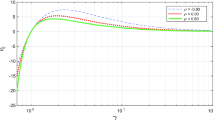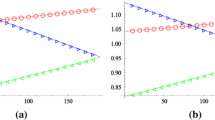Abstract
This paper investigates asset prices and the long run wealth of investors in an asset market populated by investors who have heterogeneous preferences over risk and ambiguity. In a dynamic setting I characterize conditions under which investors who are averse to ambiguity will have an effect on long run asset prices. If ambiguity averse investors always believe that the true distribution could be wrong in many possible directions then a necessary condition for their survival is that the market exhibit no aggregate risk, a condition not met by many asset pricing models of interest. However, unlike investors with irrational beliefs, there do exist markets in which ambiguity averse investors survive.
Similar content being viewed by others
References
Alchian A.A. (1950) Uncertainty, evolution and economic theory. J Polit Econ 58: 211–221
Aubin, J.-P.: Mathematical methods of game and economic theory. Studies in Mathematics and its Applications, vol. 7. Amsterdam: North-Holland (1979)
Bewley T.F. (1972) Existence of equilibria in economies with infinitely many commodities. J Econ Theory 4: 514–540
Billot A., Chateauneuf A., Gilboa I., Tallon J.-M. (2000) Sharing beliefs: between agreeing and disagreeing. Econometrica 68(3): 685–694
Blume L., Easley D. (1992) Evolution and market behavior. J Econ Theory 58: 9–40
Blume L., Easley D. (2006) If you’re so smart, why aren’t you rich? Belief selection in complete and incomplete markets. Econometrica 74(4): 929–966
Cao H.H., Wang T., Zhang H.H. (2005) Model uncertainty, limited market participation, and asset prices. Rev Financ Stud 18(4): 1219–1251
Chateauneuf A., Dana R.-A., Tallon J.-M. (2000) Optimal risk-sharing rules and equilibria with Choquet-expected-utility. J Math Econ 34: 191–214
Dana R.-A. (2004) Ambiguity, uncertainty aversion and equilibrium welfare. Econ Theory 23: 569–587
Duffie D. (1996) Dynamic Asset Pricing Theory. New Jersey, Princeton University Press
Epstein L.G., Miao J. (2003) A two-person dynamic equilibrium under ambiguity. J Econ Dyn Control 27(7): 1253–1288
Epstein L.G., Schneider M. (2003) Recursive multiple-priors. J Econ Theory 113: 1–31
Epstein, L.G., Schneider, M.: Learning under ambiguity. mimeo (2005)
Epstein L.G., Wang T. (1994) Intertemporal asset pricing under Knightian uncertainty. Econometrica 62(2): 283–322
Gilboa I., Schmeidler D. (1989) Maxmin expected utility with non-unique prior. J Math Econ 18: 141–153
Guerdjikova, A.: Evolution of wealth and asset prices in markets with case-based investors. mimeo (2004)
Hansen L.P., Sargent T.J., Tallarini T.D. (1999) Robust permanent income and pricing. Rev Econ Stud 66(4): 873–907
Kalai E., Lehrer E. (1994). Weak and strong merging of opinions. J Math Econ 23: 73–86
Knight F. (1921) Risk, Ambiguity, and Profit. Houghton, Mifflin
Maenhout P.J. (2004) Robust portfolio rules and asset pricing. Rev Financ Stud 17(4): 951–983
Rigotti L., Shannon C. (2005) Uncertainty and risk aversion in financial markets. Econometrica 73(1): 203–243
Sandroni A. (2000) Do markets favor agents able to make accurate predictions?. Econometrica 68(6): 1303–1341
Uppal R., Wang T. (2003) Model misspecification and underdiversification. J Finance 58(6): 2437–2464
Walley P. (1996) Inferences from multinomial data: learning about a bag of marbles. J R Stat Soc Ser B (Methodological) 58(1): 3–57
Yan, H.: Natural selection in financial markets: does it work? mimeo (2005)
Author information
Authors and Affiliations
Corresponding author
Additional information
I have greatly benefitted from conversations with David Easley, Karl Shell, Ani Guerdjikova, Val Lambson, Kristian Rydqvist, Liyan Yang, Josh Teitelbaum and Jayant Ganguli as well as seminar participants at Cornell University and the Midwest Economic Theory Meetings. I am grateful to the Solomon Fund for Decision Research at Cornell University for support.
Rights and permissions
About this article
Cite this article
Condie, S. Living with ambiguity: prices and survival when investors have heterogeneous preferences for ambiguity. Economic Theory 36, 81–108 (2008). https://doi.org/10.1007/s00199-007-0264-1
Received:
Revised:
Published:
Issue Date:
DOI: https://doi.org/10.1007/s00199-007-0264-1




